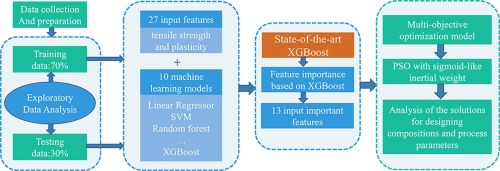当前位置:
X-MOL 学术
›
Comp. Mater. Sci.
›
论文详情
Our official English website, www.x-mol.net, welcomes your
feedback! (Note: you will need to create a separate account there.)
A steel property optimization model based on the XGBoost algorithm and improved PSO
Computational Materials Science ( IF 3.1 ) Pub Date : 2020-03-01 , DOI: 10.1016/j.commatsci.2019.109472 Kai Song , Feng Yan , Ting Ding , Liang Gao , Songbao Lu
Computational Materials Science ( IF 3.1 ) Pub Date : 2020-03-01 , DOI: 10.1016/j.commatsci.2019.109472 Kai Song , Feng Yan , Ting Ding , Liang Gao , Songbao Lu

|
Abstract Exploring the relationships between the properties of steels and their compositions and manufacturing parameters is extremely crucial and indispensable to understanding the science of materials, and subsequently developing new materials. Tensile strength and plasticity, as two important properties of steels, are key to the improvement and optimization of the mechanical properties of steels. In the present paper, we propose an optimization model combining XGBoost algorithm with improved PSO to address the continuous multivariable optimization problem. The main goal is to determine the mapping functions between the tensile strength and plasticity and their influencing factors, based on a diversity of machine learning models such as Linear Regression, SVM, XGBoost, etc. After evaluating the performance these models, we then select the XGBoost model with highest accuracy as the mapping function, which has not been done in previous studies. Moreover, the determined mapping function serves as the fitness value of particle swarm optimization, after which the tensile strength and plasticity optimization with many variables is realized. Finally, the experimental results are analyzed theoretically, and proven to be effective and reliable.
中文翻译:

基于XGBoost算法和改进PSO的钢材性能优化模型
摘要 探索钢的性能与其成分和制造参数之间的关系对于理解材料科学以及随后开发新材料至关重要。抗拉强度和塑性作为钢材的两大重要性能,是改善和优化钢材力学性能的关键。在本文中,我们提出了一种结合 XGBoost 算法和改进 PSO 的优化模型来解决连续多变量优化问题。主要目标是基于线性回归、SVM、XGBoost 等多种机器学习模型,确定拉伸强度和塑性及其影响因素之间的映射函数。在评估这些模型的性能后,然后我们选择精度最高的 XGBoost 模型作为映射函数,这在之前的研究中是没有做过的。此外,确定的映射函数作为粒子群优化的适应度值,之后实现了多变量的拉伸强度和塑性优化。最后,对实验结果进行了理论分析,证明了其有效性和可靠性。
更新日期:2020-03-01
中文翻译:

基于XGBoost算法和改进PSO的钢材性能优化模型
摘要 探索钢的性能与其成分和制造参数之间的关系对于理解材料科学以及随后开发新材料至关重要。抗拉强度和塑性作为钢材的两大重要性能,是改善和优化钢材力学性能的关键。在本文中,我们提出了一种结合 XGBoost 算法和改进 PSO 的优化模型来解决连续多变量优化问题。主要目标是基于线性回归、SVM、XGBoost 等多种机器学习模型,确定拉伸强度和塑性及其影响因素之间的映射函数。在评估这些模型的性能后,然后我们选择精度最高的 XGBoost 模型作为映射函数,这在之前的研究中是没有做过的。此外,确定的映射函数作为粒子群优化的适应度值,之后实现了多变量的拉伸强度和塑性优化。最后,对实验结果进行了理论分析,证明了其有效性和可靠性。











































 京公网安备 11010802027423号
京公网安备 11010802027423号